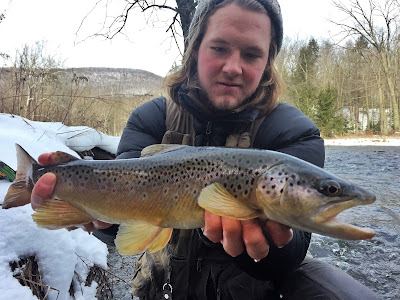My alarm clock erupts, 6am, and
through the haziness of my tired mind I quickly remember why I am up early. I’ve
got a day trip ahead of me on some of my favorite water. I am quick to rise
from my bed, put on a pot of coffee, and go through the checklist of my gear I
had organized the night before. Today I was fishing with my buddy John, a member
of the Troutbitten forum. Learning from others is something I take very
seriously. He is someone who has taught me a lot about trout fishing and a day on
the water with him always results in lessons learned.
An hour drive later we were in position on the stream as the sun was coming up, the day was going to be beautiful. Within minutes John was into fish, while I wasn’t. So the lesson begins. We made our way downstream first, walking along the snow ridden bank and stopping to fish the runs we found most appealing. Fishing slowed down, but I also wasn’t feeling confident in my drifts. I could feel they weren’t right, something needed changing. I have been recently reading and taking notes from a well-known nymphing book. I recalled I needed to improve my tuck cast and weight changing tendencies. So that’s where I decided to start.
John and I reached an island in
which he instructed me to go fish. “This is a very good run, I seldom do not
get a fish out of it” John says. So adding some weight and changing my casting
stroke some, I immediately could feel the connection between myself and my flies dramatically
improve. I was now fishing with confidence. I worked my way through the run, covering the
water in a grid system the best I could. Reaching the top, I still hadn’t gotten
anything. “You may not have caught anything out of here but at least you know a
place to try in the future” John says. “I’m not done yet” I reply. I
focus on the water rushing over the rocks dumping into the run beneath it,
gradually changing into a bit slower water. I know my drifts have been good,
and if I’m going to get anything out of this stretch, it’s going to be in my
next cast. I throw a tuck cast and plummet the flies towards the bottom, they
slip through the rocks and into the column. My sighter line pauses. Hookset.
Finally a fish on. I had to go downstream a little bit to get him out of the
current, but John put him in the net sure enough.
With drift confidence levels on the
rise, we fished our way back up to where we started and picked up a few more
fish. Within this time I rolled a very big brown that I will be back for. We
sat on the rocks along the water and observed the bug life, caddis everywhere!
After lunch the fishing continued
to be decent, we started catching fish more consistently.
Eventually things slowed down as we
continued our venture upstream. We were both getting pretty tired at this point
and had hit everything we wanted to.
John nymphing
Today, like most days on the water,
had been very beneficial to me for improving my skills as a fly fisherman. If
you want to get better, you have to be willing to change, adapt, take others
advice. Some days you also have to be conscious in understanding what you’re
doing isn’t working. That’s what made the difference for me. I recognized I wasn’t
fishing effectively to start, so I fine-tuned my drift depth by adding the
right amount of weight, and manipulated my casting stroke to zero in to where
the fish were laying. When you know your drifts are good, you try harder. I went
from a fishless day to a double digit day within two to three rig changes. Take
note of your improvement and recognize when you succeed. It’s helpful to keep
track of progress.
Fishing with John is always a good
time, and I learn a lot when I’m around him. I hope everyone out there has
someone to do the same with.
- Dando
- Dando
















